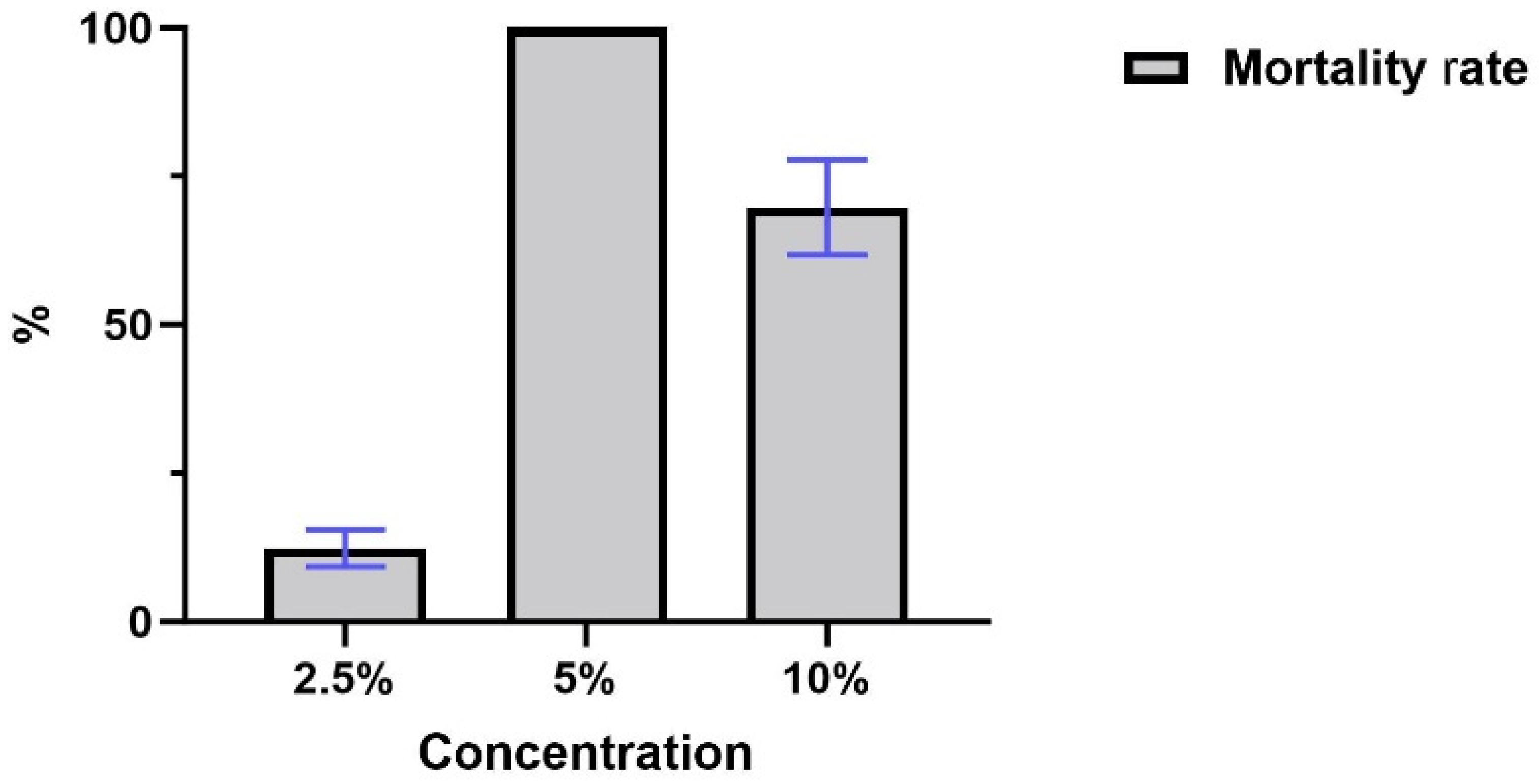The Industrial Residue of Andiroba (Carapa sp.): A Promising Source of Natural Acaricides Against Dermacentor nitens (Acari: Ixodidae)
Simple Summary
Abstract
1. Introduction
2. Materials and Methods
3. Results
4. Discussion
5. Conclusions
Supplementary Materials
Author Contributions
Funding
Institutional Review Board Statement
Informed Consent Statement
Data Availability Statement
Acknowledgments
Conflicts of Interest
References
- Dantas-Torres, F.; Fernandes Martins, T.; Muñoz-Leal, S.; Onofrio, V.C.; Barros-Battesti, D.M. Ticks (Ixodida: Argasidae, Ixodidae) of Brazil: Updated Species Checklist and Taxonomic Keys. Ticks Tick Borne Dis. 2019, 10, 101252. [Google Scholar] [CrossRef] [PubMed]
- Grisi, L.; Leite, R.C.; Martins, J.R.d.S.; de Barros, A.T.M.; Andreotti, R.; Cançado, P.H.D.; de León, A.A.P.; Pereira, J.B.; Villela, H.S. Reassessment of the Potential Economic Impact of Cattle Parasites in Brazil. Rev. Bras. Parasitol. Veterinária 2014, 23, 150–156. [Google Scholar] [CrossRef] [PubMed]
- Santos, A.C.; Cunha, R.C.; Weege, G.B.; Vianna, M.A. Theileria equi E Piroplasmose Equina, 1st ed.; Santos, A.C., Ed.; Editora Santa Cruz: São Paulo, Brazil, 2020. [Google Scholar]
- Minervino, A.H.H.; Torres, A.C.; Moreira, T.R.; Vinholte, B.P.; Sampaio, B.M.; Bianchi, D.; Portela, J.M.; Sarturi, C.; Marcili, A.; Barrêto Júnior, R.A.; et al. Factors Associated with the Prevalence of Antibodies against Theileria equi in Equids of Western Pará, Brazil. Transbound. Emerg. Dis. 2020, 67, 100–105. [Google Scholar] [CrossRef] [PubMed]
- Atanasov, A.G.; Zotchev, S.B.; Dirsch, V.M.; Orhan, I.E.; Banach, M.; Rollinger, J.M.; Barreca, D.; Weckwerth, W.; Bauer, R.; Bayer, E.A.; et al. Natural Products in Drug Discovery: Advances and Opportunities. Nat. Rev. Drug Discov. 2021, 20, 200–216. [Google Scholar] [CrossRef] [PubMed]
- Benelli, G.; Pavela, R. Beyond Mosquitoes—Essential Oil Toxicity and Repellency against Bloodsucking Insects. Ind. Crops Prod. 2018, 117, 382–392. [Google Scholar] [CrossRef]
- Pereira da Silva, V.; de Carvalho Brito, L.; Mesquita Marques, A.; da Cunha Camillo, F.; Raquel Figueiredo, M. Bioactive Limonoids from Carapa guianensis Seeds Oil and the Sustainable Use of Its By-Products. Curr. Res. Toxicol. 2023, 4, 100104. [Google Scholar] [CrossRef] [PubMed]
- Klafke, G.M.; Sabatini, G.A.; de Albuquerque, T.A.; Martins, J.R.; Kemp, D.H.; Miller, R.J.; Schumaker, T.T.S. Larval Immersion Tests with Ivermectin in Populations of the Cattle Tick Rhipicephalus (Boophilus) microplus (Acari: Ixodidae) from State of Sao Paulo, Brazil. Vet. Parasitol. 2006, 142, 386–390. [Google Scholar] [CrossRef] [PubMed]
- Abbott, W.S. A Method of Computing the Effectiveness of an Insecticide. J. Econ. Entomol. 1925, 18, 265–267. [Google Scholar] [CrossRef]
- Caesar, L.K.; Cech, N.B. Synergy and Antagonism in Natural Product Extracts: When 1 + 1 Does Not Equal 2. Nat. Prod. Rep. 2019, 36, 869–888. [Google Scholar] [CrossRef] [PubMed]
- Davis, M.J.; Svendsgaard, D.J. Nonmonotomic Dose-Response Relationships in Toxicological Studies. In Biological Effects of Low Level Exposures Dose-Response Relationships; Calabrese, E.J., Ed.; CRC Press, Inc.: Boca Raton, FL, USA, 1994; pp. 67–86. ISBN 1-56670-093-0. [Google Scholar]
- Hill, C.E.; Myers, J.P.; Vandenberg, L.N. Nonmonotonic Dose–Response Curves Occur in Dose Ranges That Are Relevant to Regulatory Decision-Making. Dose-Response 2018, 16, 1559325818798282. [Google Scholar] [CrossRef] [PubMed]
- Calabrese, E. Hormesis: Why It Is Important to Toxicology and Toxicologists. Environ. Toxicol. Chem. 2008, 27, 1451–1474. [Google Scholar] [CrossRef] [PubMed]
- Farias, M.P.O.; Sousa, D.P.; Arruda, A.C.; Wanderley, A.G.; Teixeira, W.C.; Alves, L.C.; Faustino, M.A.G. Potencial Acaricida Do Óleo de Andiroba Carapa guianensis Aubl. Sobre Fêmeas Adultas Ingurgitadas de Anocentor nitens Neumann, 1897 e Rhipicephalus sanguineus Latreille, 1806. Arq. Bras. Med. Vet. Zootec. 2009, 61, 877–882. [Google Scholar] [CrossRef]
- Vendramini, M.C.R.; Mathias, M.I.C.; De Faria, A.U.; Furquim, K.C.S.; De Souza, L.P.; Bechara, G.H.; Roma, G.C. Action of Andiroba Oil (Carapa guianensis) on Rhipicephalus sanguineus (Latreille, 1806) (Acari: Ixodidae) Semi-Engorged Females: Morphophysiological Evaluation of Reproductive System. Microsc. Res. Tech. 2012, 75, 1745–1754. [Google Scholar] [CrossRef] [PubMed]
- Sousa, A.B.B.d.; Bianchi, D.; Santos, E.M.; Dias, S.R.; Peleja, P.L.; Santos, R.R.; Mercado Caruso, N.; Minervino, A.H.H. First Description of Acaricide Resistance in Populations of Rhipicephalus microplus Tick from the Lower Amazon, Brazil. Animals 2022, 12, 2931. [Google Scholar] [CrossRef] [PubMed]
- Isman, M.B. Botanical insecticides, deterrents, and repellents in modern agriculture and an increasingly regulated world. Annu. Rev. Entomol. 2006, 51, 45–66. [Google Scholar] [CrossRef] [PubMed]
- Arnold, J.E.M.; Pérez, M.R. Can Non-Timber Forest Products Match Tropical Forest Conservation and Development Objectives? Ecol. Econ. 2001, 39, 437–447. [Google Scholar] [CrossRef]


Disclaimer/Publisher’s Note: The statements, opinions and data contained in all publications are solely those of the individual author(s) and contributor(s) and not of MDPI and/or the editor(s). MDPI and/or the editor(s) disclaim responsibility for any injury to people or property resulting from any ideas, methods, instructions or products referred to in the content. |
© 2025 by the authors. Licensee MDPI, Basel, Switzerland. This article is an open access article distributed under the terms and conditions of the Creative Commons Attribution (CC BY) license (https://creativecommons.org/licenses/by/4.0/).
Share and Cite
Bianchi, D.; Santos, R.R.d.; Peleja, P.L.; de Sousa, A.B.B.; da Silva Evangelista, M.; de Almeida Júnior, J.S.; Barata, L.E.S.; Moraes, W.P.; Minervino, A.H.H. The Industrial Residue of Andiroba (Carapa sp.): A Promising Source of Natural Acaricides Against Dermacentor nitens (Acari: Ixodidae). Vet. Sci. 2025, 12, 421. https://doi.org/10.3390/vetsci12050421
Bianchi D, Santos RRd, Peleja PL, de Sousa ABB, da Silva Evangelista M, de Almeida Júnior JS, Barata LES, Moraes WP, Minervino AHH. The Industrial Residue of Andiroba (Carapa sp.): A Promising Source of Natural Acaricides Against Dermacentor nitens (Acari: Ixodidae). Veterinary Sciences. 2025; 12(5):421. https://doi.org/10.3390/vetsci12050421
Chicago/Turabian StyleBianchi, Daniela, Raidel Reis dos Santos, Poliana Leão Peleja, Ana Beatriz Barbosa de Sousa, Marcelo da Silva Evangelista, José Sousa de Almeida Júnior, Lauro Euclides Soares Barata, Waldiney Pires Moraes, and Antonio Humberto Hamad Minervino. 2025. "The Industrial Residue of Andiroba (Carapa sp.): A Promising Source of Natural Acaricides Against Dermacentor nitens (Acari: Ixodidae)" Veterinary Sciences 12, no. 5: 421. https://doi.org/10.3390/vetsci12050421
APA StyleBianchi, D., Santos, R. R. d., Peleja, P. L., de Sousa, A. B. B., da Silva Evangelista, M., de Almeida Júnior, J. S., Barata, L. E. S., Moraes, W. P., & Minervino, A. H. H. (2025). The Industrial Residue of Andiroba (Carapa sp.): A Promising Source of Natural Acaricides Against Dermacentor nitens (Acari: Ixodidae). Veterinary Sciences, 12(5), 421. https://doi.org/10.3390/vetsci12050421









